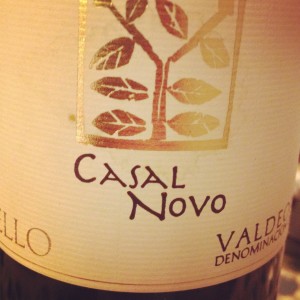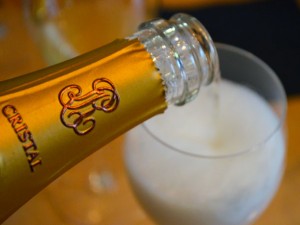 Looking for a white wine amongst the bottles I had lying around, I realized I had this 2006 Godello from Spain’s Valdeorras region, put down and forgotten for a few years. Valdeorras is a denominación de origen (DO) from Galicia, in the country’s coastal, northwest region, and wines made of Godello tend to have the big stone and tree fruit of their more famous coastal compatriot Albariño, but with an greater level of acidity. Continue reading
Looking for a white wine amongst the bottles I had lying around, I realized I had this 2006 Godello from Spain’s Valdeorras region, put down and forgotten for a few years. Valdeorras is a denominación de origen (DO) from Galicia, in the country’s coastal, northwest region, and wines made of Godello tend to have the big stone and tree fruit of their more famous coastal compatriot Albariño, but with an greater level of acidity. Continue reading
Monthly Archives: January 2013
mas (la grillade) in New York
 My boyfriend and I celebrated our anniversary together a few months ago with a four course tasting menu at mas (la grillade) in New York. Here, everything is prepared on huge grills, with different woods paired with the different kinds of meat, fish, and other goodies featured on the menu. Continue reading
My boyfriend and I celebrated our anniversary together a few months ago with a four course tasting menu at mas (la grillade) in New York. Here, everything is prepared on huge grills, with different woods paired with the different kinds of meat, fish, and other goodies featured on the menu. Continue reading
A Round-Up of Recent Articles
Champagne is a supremely great wine to pair with food, and—particularly great for Thanksgiving—its sparkling style transitions easily among different flavors and textures. Bottles may vary in style, body, and sweetness, but a good, dry Brut goes nicely with almost anything. Typically high in acid and filled with soft bubbles, it can be tart and refreshing, a great palate cleanser between bites. Plus, you won’t have to worry about opening a bottle and not finishing it—at least, not if you have a crowd like mine. Full article here.
When it’s cold outside, I’m no longer looking for a refreshing drink; rather, I want to sip something rich and warming. This year, my solution is a rich, full-bodied pinot gris from Alsace: Zind-Humbrecht’s Pinot Gris Grand Cru is a mouthful, both in name and in flavor.
Full article here.
A relative of sauvignon blanc, this pink-skinned grape produces a wine with a sweet, acidic nose, reminiscent of dried oranges and tangerines, fuller on the palate than its zippy brother—all around, this bottle is perfect for sipping on a cool late-summer evening, and goes great with oysters, mussels, and other richer seafoods.
Full article here.
On Flavorwire.com:
Ever wonder what you’re supposed to look for when a server pours wine into your glass? Or had a mild panic attack when a clerk in a wine shop asks you what you’re looking for? Even if you know next to zero about wine, you still need to be able to order a glass. Check out our guide to faking your way through your next dinner date, from a few wine words to know to connoisseur-worthy deals. And if you’re talking to a wine snob at your next cocktail party, you may even be able to teach ‘em a thing or two.
Full article here.
With only one day in New Zealand’s Marlborough wine region, I wanted to find a way to quickly connect with the land known for its beautifully acidic and fruity wines. More specifically, I was on the hunt to discover Marlborough’s aromatic varieties such as Riesling and Pinot Gris, most of which don’t make it to the United States.
Full article here.
On YouTube’s Hungry Channel:
Not so much an article but a featured appearance as a judge for the Latke Challenge. Full video here.
How to Fake Like You Know Wine
Adapted for Flavorwire.
Ever wonder what you’re supposed to look for when a server pours wine into your glass? Or had a mild panic attack when a clerk in a wine shop asks you what you’re looking for? Even if you know next to zero about wine, you still need to be able to order a glass. Check out our guide to faking your way through your next dinner date, from a few wine words to know to connoisseur-worthy deals. And if you’re talking to a wine snob at your next cocktail party, you may even be able to teach ’em a thing or two.
Wine Terms to Know
If you want to sound like you know wine, it’s good to have a few terms in your vocab to talk about what you like or don’t like. That California Chardonnay? It’s buttery, creamy, and round. You may even say it’s a little oaky, since it’s been aged in the wood. Prefer a New Zealand Sauvignon Blanc? Means you’re more into an acidic, fruity, minerally white that’s a little lighter in body. As for red, an Australian Shiraz is also pretty fruity, even jammy (that big fruit flavor really packs a punch), while a Cabernet Sauvignon from France’s Bordeaux is more tannic, that quality that can make a red wine taste a little rough but gives it the structure it needs over time to smooth out and age. Once you use these words, you may even start to notice trends in the wines you like (fruity, earthy, and did I just get a whiff of chocolate?)
Old World versus New World
Winemaking differences aside (and there are many), the main point of distinction for you when picking up a bottle is whether the appellation or variety is listed on the label. It’s good to know that wine labeling falls into two camps: Old World (mostly Europe) and New World (everywhere else). New World wines are fairly straightforward, listing the grapes (or the one that’s in the majority) right on the label: Cabernet Sauvignon, Chardonnay, Sauvignon Blanc, you get the point. But if you wanna know if it was aged in oak or stainless steel, you may have to read the back label closely to get more information about the style.
Old World wines make you think a little harder. They will list the appellation, not the grape, which means that a little knowledge about that place tells you not only the grape (or grapes) but also the style. A good non-vintage Champagne will be a blend of Chardonnay, Pinot Noir, and Pinot Meunier, and it’ll have aged at least 15 months in bottle, if not longer. Well-known regions you should know? Chablis, an unoaked Chardonnay from northern Burgundy; Sancerre, a minerally Sauvignon Blanc from the Loire Valley; and Chianti, an acidic red wine made of the Sangiovese grape from the Italian region that happens to go great with food.
Quick Label Identification
Unless you’re studying to be a Master Sommelier, you probably don’t need to know every California AVA in the book. But it does help to know a little bit about what you’re looking at when you check out a label. Both Old World and New World wines will list the producer name (Robert Mondavi), vintage (2010), and alcohol by volume percentage (13.5%). The region is listed as well, and it’s a pretty good indicator of the quality level of the wine — the more vague (California) will be a more entry-level wine, while a more specific notation (Napa Valley, Single Vineyard) means the grapes are from a concentrated vineyard area with a higher quality control. As for the grape? See Old World versus New World above.
Do Hold by the Stem
There are a lot of opinions on the temperature at which a red wine versus a white wine should be served. Although it varies by grape and style, whites as a rule are generally chilled, while reds are served a little below room temperature. Especially if you’re in a fancy restaurant or at the home of a wine connoisseur, the way you hold your glass of wine tells a lot about your level of knowledge. How to look like you know what you’re doing? No matter what the wine, hold the glass by the stem, instead of gripping the bowl — it keeps the temperature of the wine the way it should be longer. And whatever you do, don’t put ice in your glass… unless it’s filled with water.
No More Nouveau
If you want to play the savvy French wine snob who knows a deal, there are lesser-known regions producing killer wines for a better price than a Chateau Lafite. These wines are some of the best wines for the best price coming from France, and you’ll look like you really have the inside scoop. Like lighter reds? Look for wines from the Beaujolais — no, not the yellow-labeled Nouveau that comes out in November. You want wines from the Crus regions, like Fleurie, Morgon, and Régnié, elegant reds made from the gamay grape, Pinot Noir’s redheaded stepsister. For fresh whites, try Sancerre’s neighboring towns like Quincy, Pouilly-Fumé, and Touraine. They’ll share some of those minerally aspects of the famous Sauvignon Blanc at a more approachable price. Still hankering for that Lafite? The Côtes du Rhône region makes gorgeous, rich, full-bodied reds from north to south, from Cornas to Vacqueyras.
Ask a Somm
Ever been confronted by a book rather than a simple wine list? Don’t know what a Txakolí is? Or simply don’t recognize any of the brands on the menu? If you really want to act like you know what you’re doing, then quit pretending and ask an expert. Every restaurant’s sommelier or beverage director intimately knows the wines on their list and can recommend wines at your price point and to your taste (same goes for your local wine shop). All you need to tell them is what you like (Fuller-bodied whites like a California Chardonnay? Cabernet’s your fave?) and what you want to spend (I’d like to keep it in this range — and don’t hesitate to point if you’d rather not say in front of your date). This way, you’ll show yourself to be an adventurous wine-lover, ready to try something new.
But, no, you cannot just send it back if you don’t like it. When in doubt, ask for a taste of something off the by-the-glass menu and then order the bottle if you like it.


